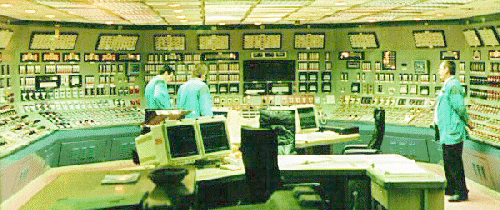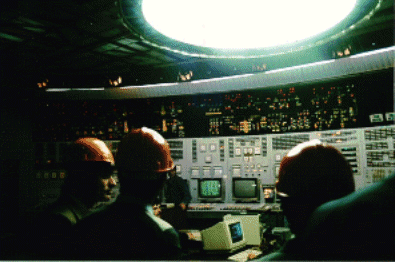
Main Control Rooms
The Main Control Room in all countries is used as the main control center in the plant. The plant operating supervisor and senior operating personnel operate and monitor major plant equipment.
Most designs include a combination of vertical panels and bench boards. Equipment indications and controls are organized by system. Annunciators (small windows) with a sound alarm are usually placed above the control board or at the top part of the control board. The plant computer is also used to provide alarms alerting the operator to problems. Less frequently used equipment is usually placed on panels in the back part of the control room or behind the main control board.
Control rooms vary in size from about 50 feet x 50 feet to 50 x 100 feet. In some cases, two units are controlled from a single control room.
The photos below illustrate the various control room concepts.
US and European Designs
Below is the compact horseshoe shape control room design used on many Westinghouse 2 Loop Reactor facilities. The control panel is usually divided into three parts:
The annunciator (alarm) panels are located along the top to alert the operators to potential equipment problems or unusual conditions.

This picture is taken from the vantage point of the supervisor, who often supervises 2 or 3 control room operators. The control room operators in many countries are licensed by the regulatory agency. These operators perform tests of emergency equipment to ensure that it will operate when needed. The licensed operators are required to complete ongoing requalification training and simulator emergency drill training throughout the year. A plant will normally have 5 or 6 operating crews who operate the plant around the clock. Each crew spends part of their 5 or 6 week cycle on each of the shifts - days, afternoons, and midnights. At some plants, operators may work two-12 hour shifts (e.g. 3 days one week and 4 the next).
Below is the control room layout provided for a Framatome reactor .
 |
In most designs, each system has its own control panel. The bench board as on the left is used for more commonly operated equipment. |
The German KWU and Siemens plants tend to use miniaturized control switches and indicators to allow smaller control rooms.
Japanese Design
The photo below shows the control room of a Mitsubishi PWR facility. Television cameras are located in various areas of the plant to allow more monitoring from the main control room. If an unusual condition occurs, an operator is sent from the control room to correct the condition in the field.
\ Photo by J.A. Gonyeau |
In most power plants, alarm panels are located on the upper part of the control board. Indicators and recorders are located on the lower vertical portion of the panel, Control switches for pumps and valves are located on the lower, usually horizontal, portion of the control panel. In some facilities as this Japanese plant, control room personnel wear uniforms.
|
Russian and East European Designs
Russian and Eastern European plants often use a mimic design plan as shown in the pictures below.
 |
The mimic concept uses simplified sketches of major
plant systems provided on the uppermost panels.
Note the uppermost panel has a number of red and green lights. In power plants typically green indicates a valve is closed or a breaker is open. Red indicates valve open or a breaker is closed. In some power plants alarm lights are included within the system flow path. Usually, alarm lights are mounted separately in massive arrays. |
 Photo by J.A. Gonyeau |
The Control Room of a VVER-1000 plant.
The colored panel above, sometimes called a mimic panel, shows the position of valves (open, close, mid-position), status of pumps (operating or not) and other equipment. The middle panels contain meters and computer monitors to tell the operator operating conditions. Horizontal bench board panels contain controls for operating equipment. |
The control room operators and supervisors are the more senior personnel in the power plant. They direct the activities of operators in the outer areas of the plant. These field operators inspect the condition of the operating equipment, lineup equipment for starting and maintenance, and perform minor maintenance, e.g. greasing, adding oil, cleaning equipment. Sometimes the field operators are stationed in, and dispatched from, the control room; sometimes they have their own assigned workstations.
The picture below illustrates a RBMK plant control board design.| Many Russian-designed plant control rooms use a bench board
that is in
front of the tall vertical panels.
Frequently used equipment control switches are usually mounted on the bench board (where the operator is standing). The back panels contain indicators, recorders, and controls for less frequently operated equipment. |
|
Copyright © 1996-2004. Joseph Gonyeau, P.E.. The Virtual Nuclear Tourist. All rights reserved. Revised: March 15, 2001.